Authenticity and Authority of the Bible Assessment - Vision College
VerifiedAdded on 2022/09/18
|39
|7771
|29
Homework Assignment
AI Summary
This document presents a solved multiple-choice assessment on the authenticity and authority of the Bible, originating from Vision College. The assessment covers a wide range of topics, including the formation of the Old and New Testament canons, the Apocrypha, and the significance of the 'day of the pulpit.' It explores key concepts like divine inspiration, revelation, and the role of personal experience in spiritual life. The questions delve into the differences between the Bible and the Koran, the sources of spiritual authority, and the importance of the Bible's historical claims. It examines the historical context, including the influence of figures like Moses, Ezra, and the impact of the exile. The assignment tests the understanding of the Bible's unique characteristics and its relationship with the concept of salvation. This assignment is a valuable resource for students studying the Bible, offering insights into its authenticity, authority, and key doctrines.
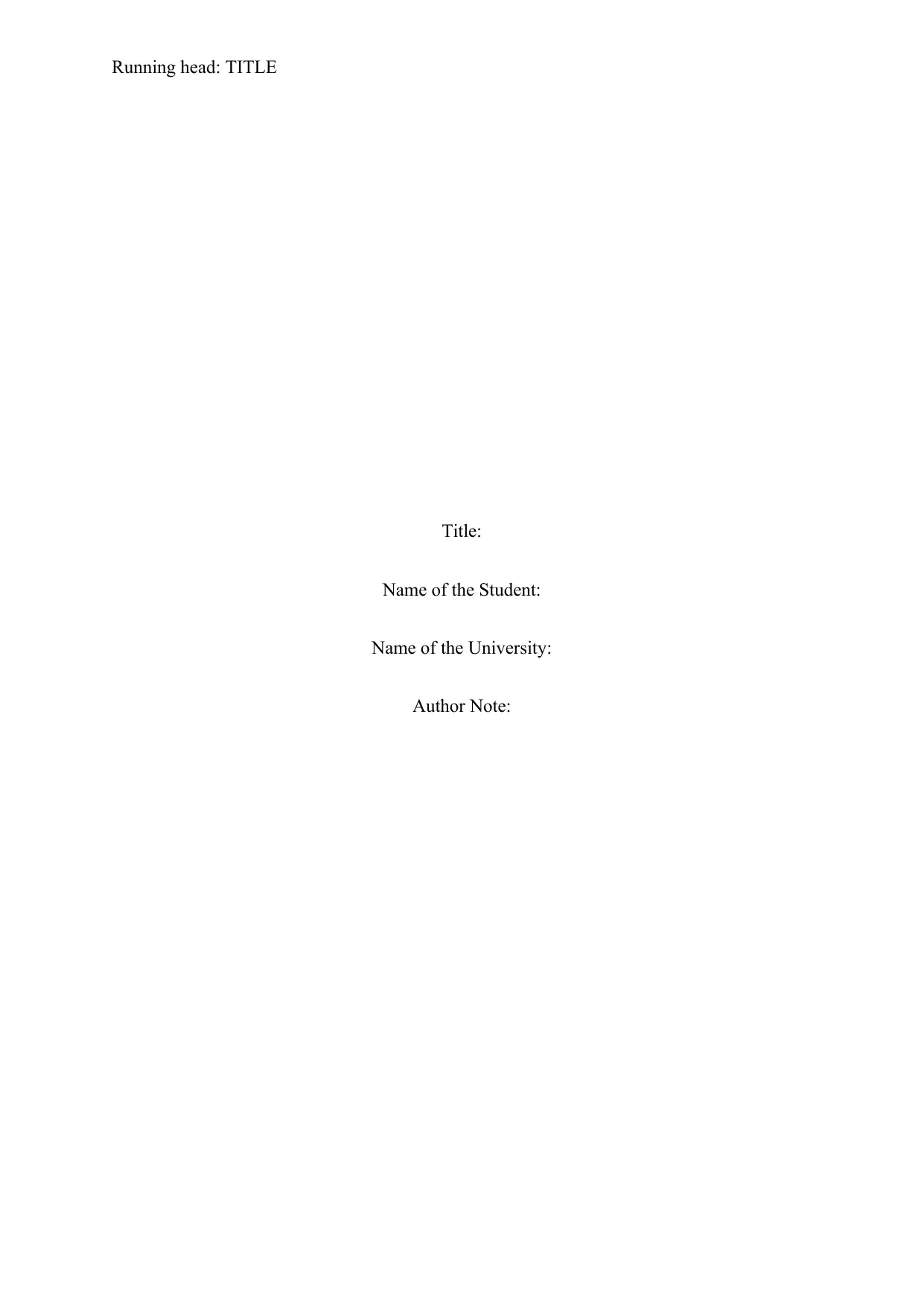
Running head: TITLE
Title:
Name of the Student:
Name of the University:
Author Note:
Title:
Name of the Student:
Name of the University:
Author Note:
Paraphrase This Document
Need a fresh take? Get an instant paraphrase of this document with our AI Paraphraser
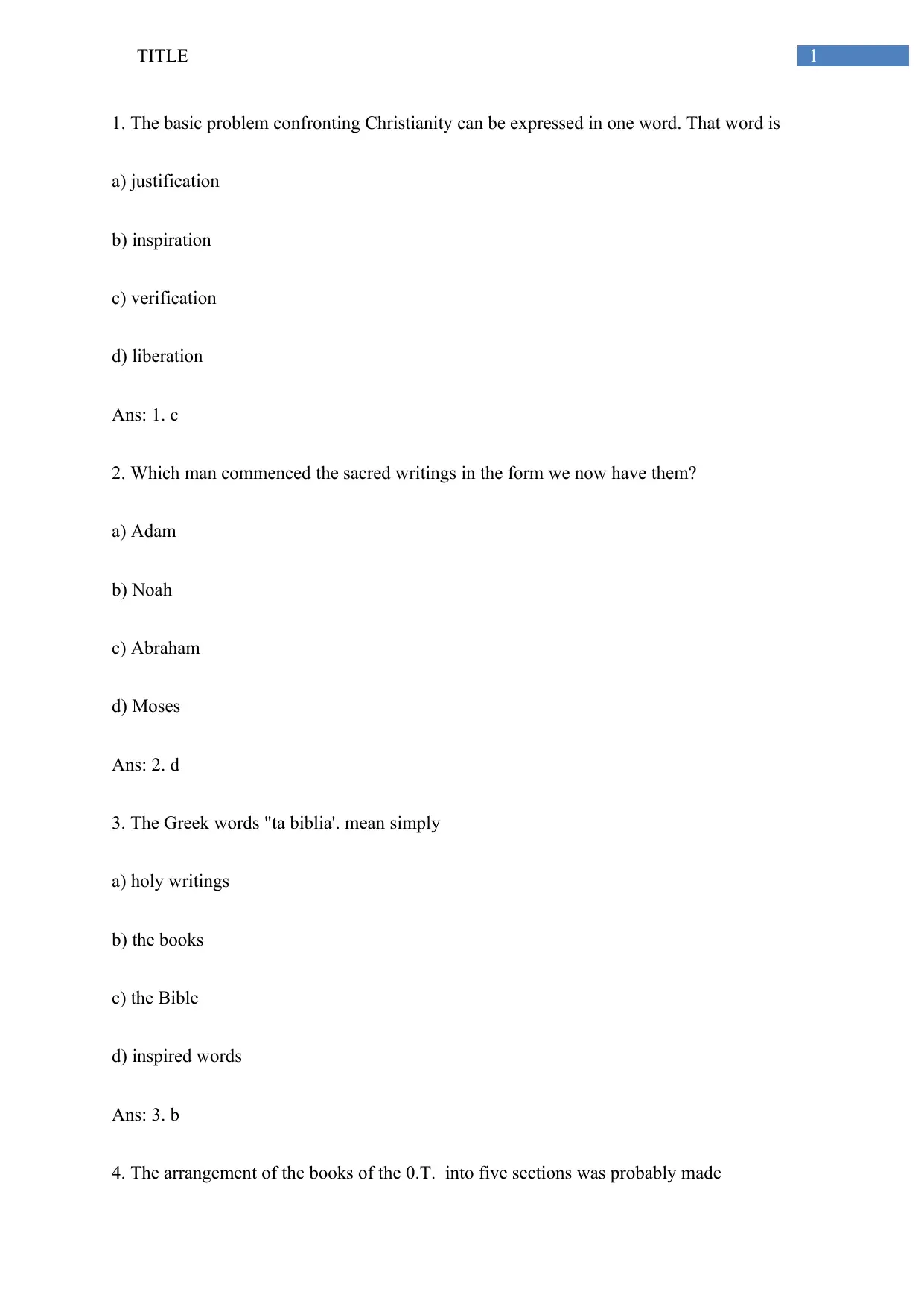
1TITLE
1. The basic problem confronting Christianity can be expressed in one word. That word is
a) justification
b) inspiration
c) verification
d) liberation
Ans: 1. c
2. Which man commenced the sacred writings in the form we now have them?
a) Adam
b) Noah
c) Abraham
d) Moses
Ans: 2. d
3. The Greek words "ta biblia'. mean simply
a) holy writings
b) the books
c) the Bible
d) inspired words
Ans: 3. b
4. The arrangement of the books of the 0.T. into five sections was probably made
1. The basic problem confronting Christianity can be expressed in one word. That word is
a) justification
b) inspiration
c) verification
d) liberation
Ans: 1. c
2. Which man commenced the sacred writings in the form we now have them?
a) Adam
b) Noah
c) Abraham
d) Moses
Ans: 2. d
3. The Greek words "ta biblia'. mean simply
a) holy writings
b) the books
c) the Bible
d) inspired words
Ans: 3. b
4. The arrangement of the books of the 0.T. into five sections was probably made
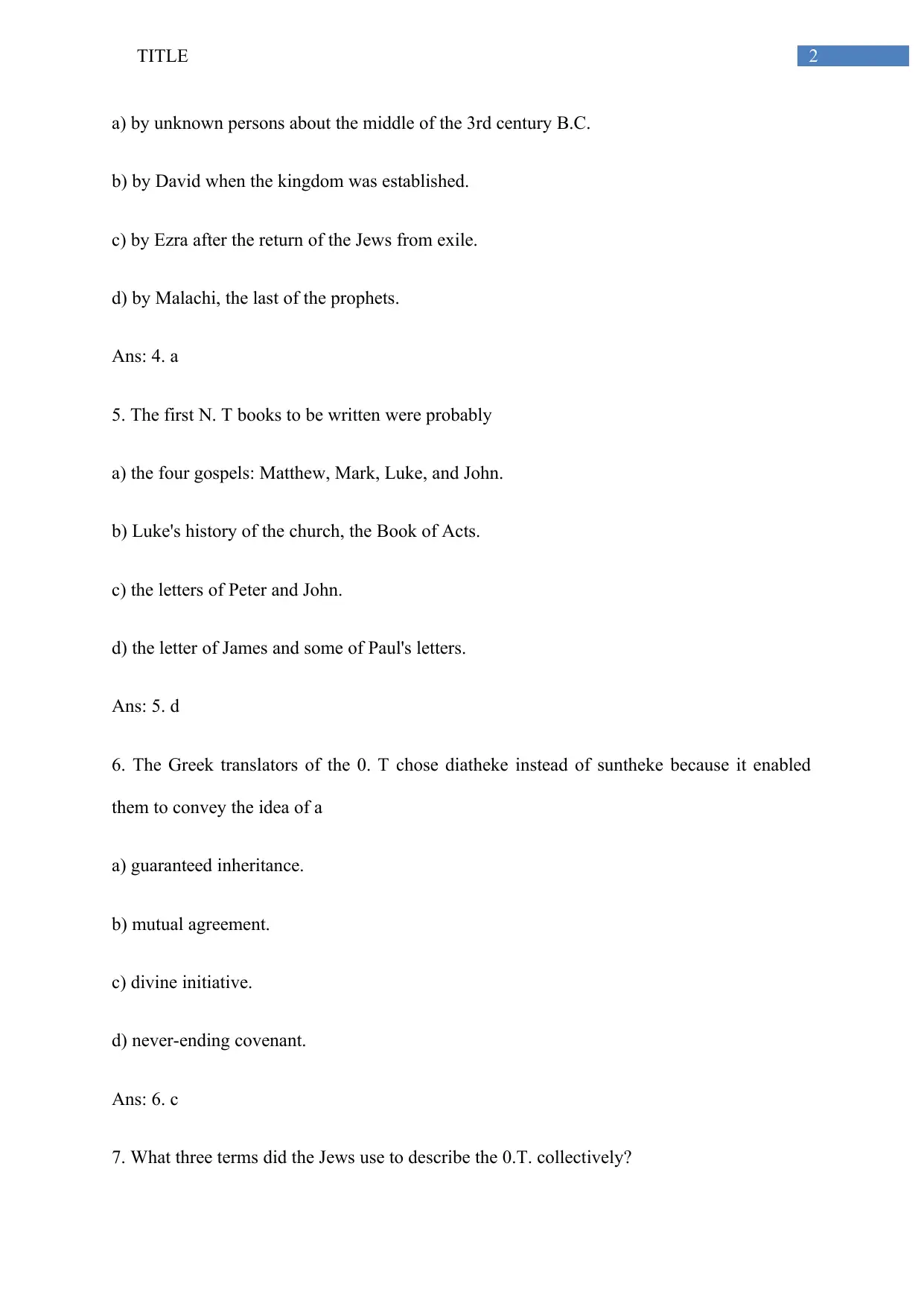
2TITLE
a) by unknown persons about the middle of the 3rd century B.C.
b) by David when the kingdom was established.
c) by Ezra after the return of the Jews from exile.
d) by Malachi, the last of the prophets.
Ans: 4. a
5. The first N. T books to be written were probably
a) the four gospels: Matthew, Mark, Luke, and John.
b) Luke's history of the church, the Book of Acts.
c) the letters of Peter and John.
d) the letter of James and some of Paul's letters.
Ans: 5. d
6. The Greek translators of the 0. T chose diatheke instead of suntheke because it enabled
them to convey the idea of a
a) guaranteed inheritance.
b) mutual agreement.
c) divine initiative.
d) never-ending covenant.
Ans: 6. c
7. What three terms did the Jews use to describe the 0.T. collectively?
a) by unknown persons about the middle of the 3rd century B.C.
b) by David when the kingdom was established.
c) by Ezra after the return of the Jews from exile.
d) by Malachi, the last of the prophets.
Ans: 4. a
5. The first N. T books to be written were probably
a) the four gospels: Matthew, Mark, Luke, and John.
b) Luke's history of the church, the Book of Acts.
c) the letters of Peter and John.
d) the letter of James and some of Paul's letters.
Ans: 5. d
6. The Greek translators of the 0. T chose diatheke instead of suntheke because it enabled
them to convey the idea of a
a) guaranteed inheritance.
b) mutual agreement.
c) divine initiative.
d) never-ending covenant.
Ans: 6. c
7. What three terms did the Jews use to describe the 0.T. collectively?
⊘ This is a preview!⊘
Do you want full access?
Subscribe today to unlock all pages.

Trusted by 1+ million students worldwide
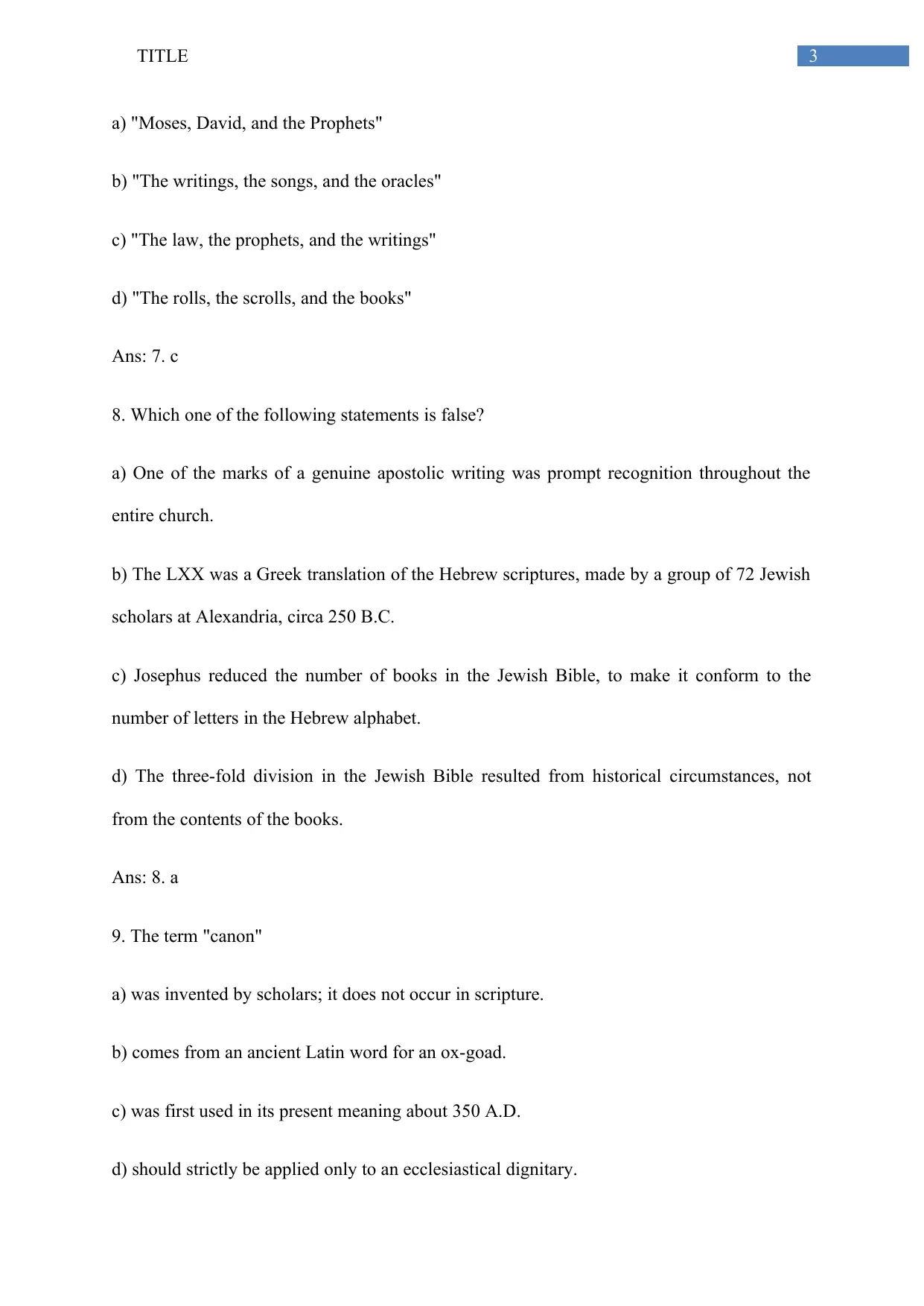
3TITLE
a) "Moses, David, and the Prophets"
b) "The writings, the songs, and the oracles"
c) "The law, the prophets, and the writings"
d) "The rolls, the scrolls, and the books"
Ans: 7. c
8. Which one of the following statements is false?
a) One of the marks of a genuine apostolic writing was prompt recognition throughout the
entire church.
b) The LXX was a Greek translation of the Hebrew scriptures, made by a group of 72 Jewish
scholars at Alexandria, circa 250 B.C.
c) Josephus reduced the number of books in the Jewish Bible, to make it conform to the
number of letters in the Hebrew alphabet.
d) The three-fold division in the Jewish Bible resulted from historical circumstances, not
from the contents of the books.
Ans: 8. a
9. The term "canon"
a) was invented by scholars; it does not occur in scripture.
b) comes from an ancient Latin word for an ox-goad.
c) was first used in its present meaning about 350 A.D.
d) should strictly be applied only to an ecclesiastical dignitary.
a) "Moses, David, and the Prophets"
b) "The writings, the songs, and the oracles"
c) "The law, the prophets, and the writings"
d) "The rolls, the scrolls, and the books"
Ans: 7. c
8. Which one of the following statements is false?
a) One of the marks of a genuine apostolic writing was prompt recognition throughout the
entire church.
b) The LXX was a Greek translation of the Hebrew scriptures, made by a group of 72 Jewish
scholars at Alexandria, circa 250 B.C.
c) Josephus reduced the number of books in the Jewish Bible, to make it conform to the
number of letters in the Hebrew alphabet.
d) The three-fold division in the Jewish Bible resulted from historical circumstances, not
from the contents of the books.
Ans: 8. a
9. The term "canon"
a) was invented by scholars; it does not occur in scripture.
b) comes from an ancient Latin word for an ox-goad.
c) was first used in its present meaning about 350 A.D.
d) should strictly be applied only to an ecclesiastical dignitary.
Paraphrase This Document
Need a fresh take? Get an instant paraphrase of this document with our AI Paraphraser
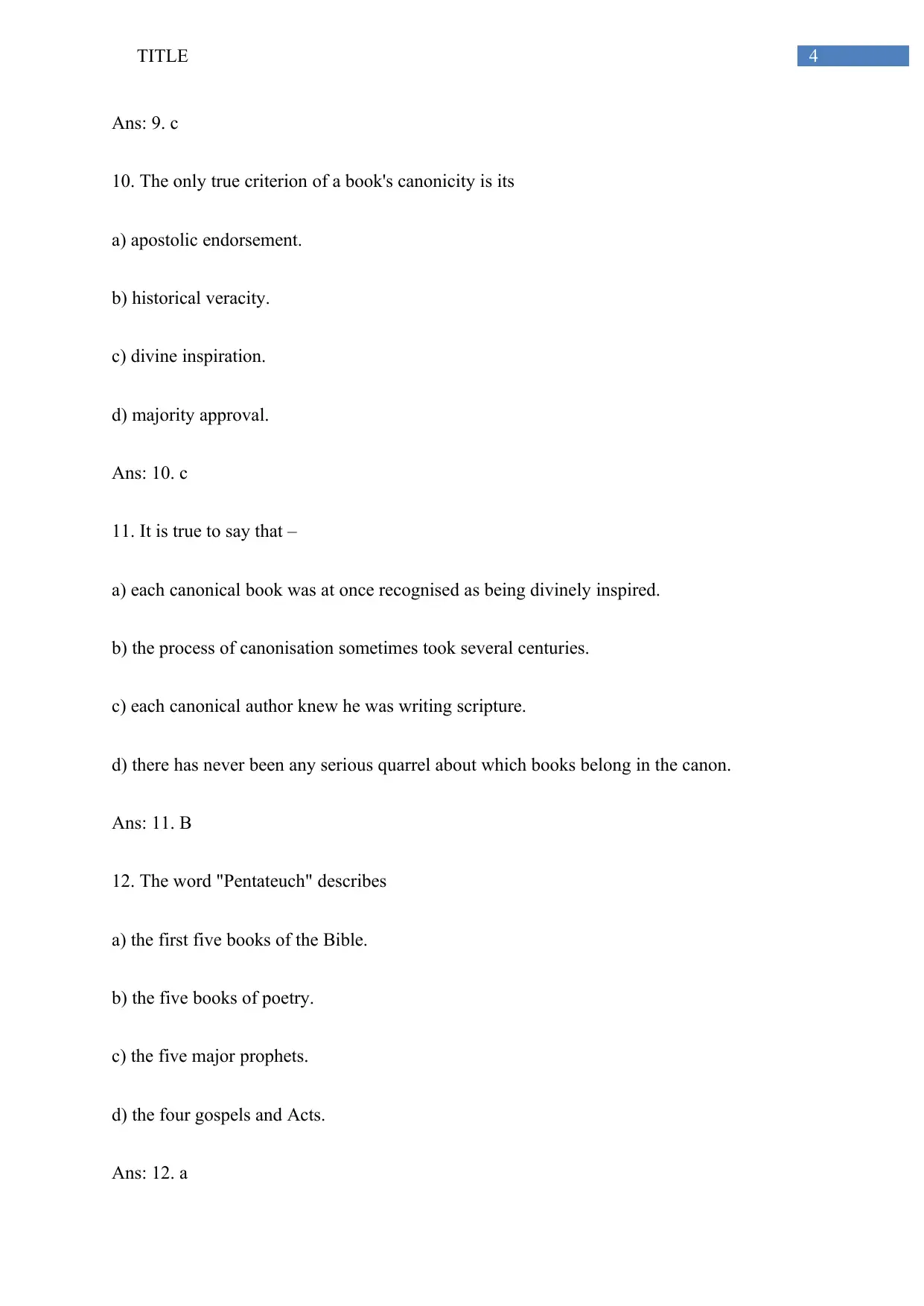
4TITLE
Ans: 9. c
10. The only true criterion of a book's canonicity is its
a) apostolic endorsement.
b) historical veracity.
c) divine inspiration.
d) majority approval.
Ans: 10. c
11. It is true to say that –
a) each canonical book was at once recognised as being divinely inspired.
b) the process of canonisation sometimes took several centuries.
c) each canonical author knew he was writing scripture.
d) there has never been any serious quarrel about which books belong in the canon.
Ans: 11. B
12. The word "Pentateuch" describes
a) the first five books of the Bible.
b) the five books of poetry.
c) the five major prophets.
d) the four gospels and Acts.
Ans: 12. a
Ans: 9. c
10. The only true criterion of a book's canonicity is its
a) apostolic endorsement.
b) historical veracity.
c) divine inspiration.
d) majority approval.
Ans: 10. c
11. It is true to say that –
a) each canonical book was at once recognised as being divinely inspired.
b) the process of canonisation sometimes took several centuries.
c) each canonical author knew he was writing scripture.
d) there has never been any serious quarrel about which books belong in the canon.
Ans: 11. B
12. The word "Pentateuch" describes
a) the first five books of the Bible.
b) the five books of poetry.
c) the five major prophets.
d) the four gospels and Acts.
Ans: 12. a
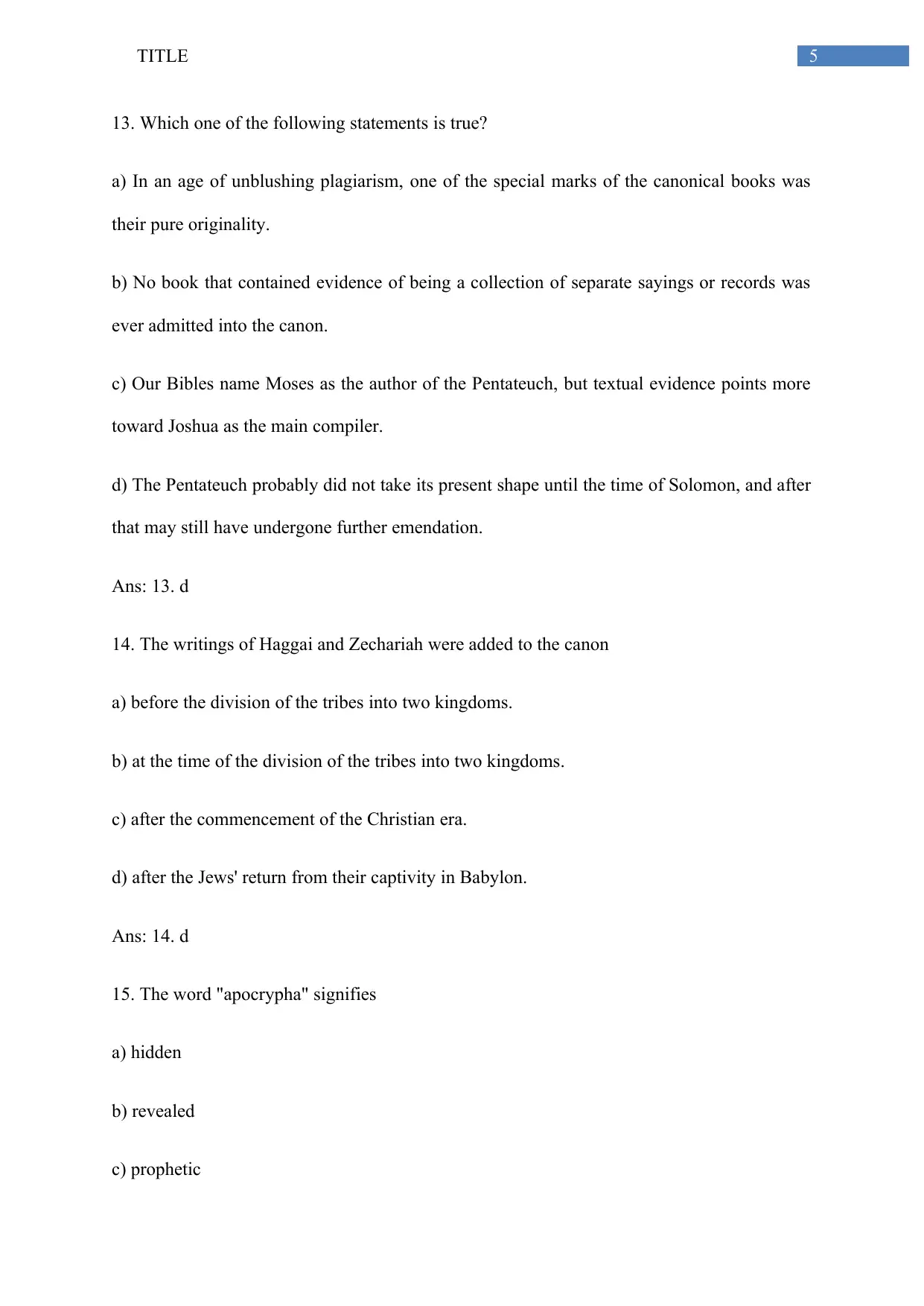
5TITLE
13. Which one of the following statements is true?
a) In an age of unblushing plagiarism, one of the special marks of the canonical books was
their pure originality.
b) No book that contained evidence of being a collection of separate sayings or records was
ever admitted into the canon.
c) Our Bibles name Moses as the author of the Pentateuch, but textual evidence points more
toward Joshua as the main compiler.
d) The Pentateuch probably did not take its present shape until the time of Solomon, and after
that may still have undergone further emendation.
Ans: 13. d
14. The writings of Haggai and Zechariah were added to the canon
a) before the division of the tribes into two kingdoms.
b) at the time of the division of the tribes into two kingdoms.
c) after the commencement of the Christian era.
d) after the Jews' return from their captivity in Babylon.
Ans: 14. d
15. The word "apocrypha" signifies
a) hidden
b) revealed
c) prophetic
13. Which one of the following statements is true?
a) In an age of unblushing plagiarism, one of the special marks of the canonical books was
their pure originality.
b) No book that contained evidence of being a collection of separate sayings or records was
ever admitted into the canon.
c) Our Bibles name Moses as the author of the Pentateuch, but textual evidence points more
toward Joshua as the main compiler.
d) The Pentateuch probably did not take its present shape until the time of Solomon, and after
that may still have undergone further emendation.
Ans: 13. d
14. The writings of Haggai and Zechariah were added to the canon
a) before the division of the tribes into two kingdoms.
b) at the time of the division of the tribes into two kingdoms.
c) after the commencement of the Christian era.
d) after the Jews' return from their captivity in Babylon.
Ans: 14. d
15. The word "apocrypha" signifies
a) hidden
b) revealed
c) prophetic
⊘ This is a preview!⊘
Do you want full access?
Subscribe today to unlock all pages.

Trusted by 1+ million students worldwide
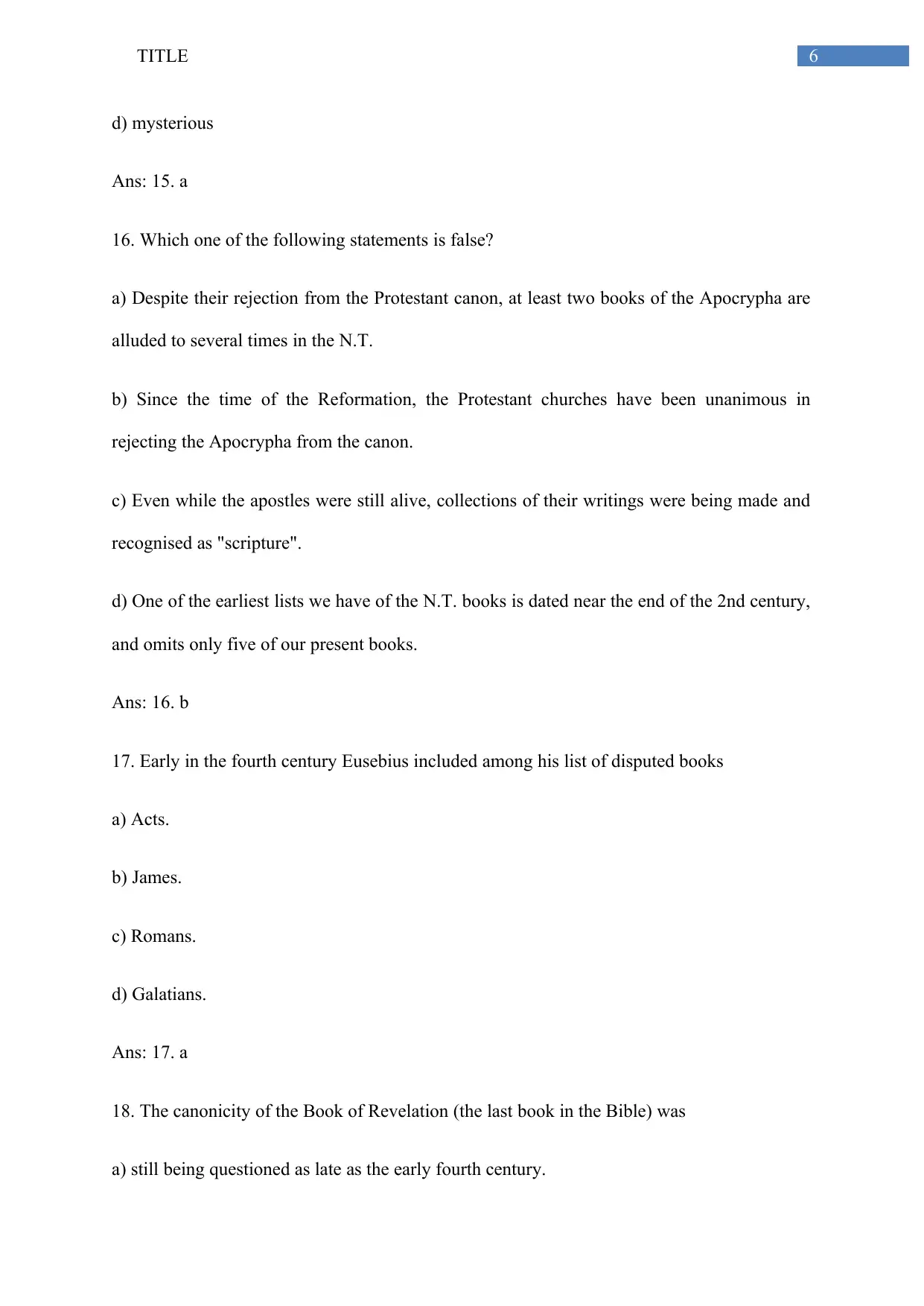
6TITLE
d) mysterious
Ans: 15. a
16. Which one of the following statements is false?
a) Despite their rejection from the Protestant canon, at least two books of the Apocrypha are
alluded to several times in the N.T.
b) Since the time of the Reformation, the Protestant churches have been unanimous in
rejecting the Apocrypha from the canon.
c) Even while the apostles were still alive, collections of their writings were being made and
recognised as "scripture".
d) One of the earliest lists we have of the N.T. books is dated near the end of the 2nd century,
and omits only five of our present books.
Ans: 16. b
17. Early in the fourth century Eusebius included among his list of disputed books
a) Acts.
b) James.
c) Romans.
d) Galatians.
Ans: 17. a
18. The canonicity of the Book of Revelation (the last book in the Bible) was
a) still being questioned as late as the early fourth century.
d) mysterious
Ans: 15. a
16. Which one of the following statements is false?
a) Despite their rejection from the Protestant canon, at least two books of the Apocrypha are
alluded to several times in the N.T.
b) Since the time of the Reformation, the Protestant churches have been unanimous in
rejecting the Apocrypha from the canon.
c) Even while the apostles were still alive, collections of their writings were being made and
recognised as "scripture".
d) One of the earliest lists we have of the N.T. books is dated near the end of the 2nd century,
and omits only five of our present books.
Ans: 16. b
17. Early in the fourth century Eusebius included among his list of disputed books
a) Acts.
b) James.
c) Romans.
d) Galatians.
Ans: 17. a
18. The canonicity of the Book of Revelation (the last book in the Bible) was
a) still being questioned as late as the early fourth century.
Paraphrase This Document
Need a fresh take? Get an instant paraphrase of this document with our AI Paraphraser
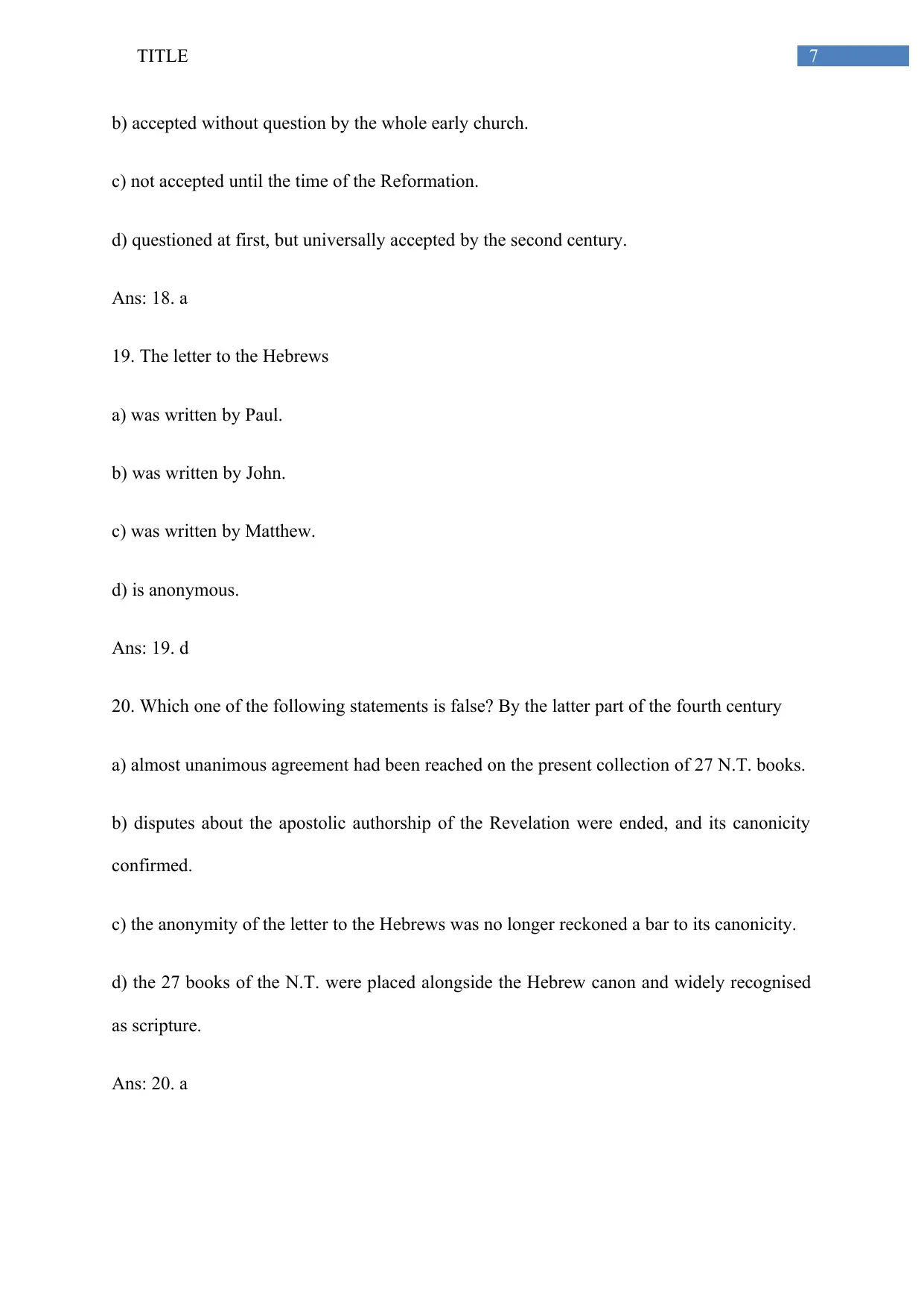
7TITLE
b) accepted without question by the whole early church.
c) not accepted until the time of the Reformation.
d) questioned at first, but universally accepted by the second century.
Ans: 18. a
19. The letter to the Hebrews
a) was written by Paul.
b) was written by John.
c) was written by Matthew.
d) is anonymous.
Ans: 19. d
20. Which one of the following statements is false? By the latter part of the fourth century
a) almost unanimous agreement had been reached on the present collection of 27 N.T. books.
b) disputes about the apostolic authorship of the Revelation were ended, and its canonicity
confirmed.
c) the anonymity of the letter to the Hebrews was no longer reckoned a bar to its canonicity.
d) the 27 books of the N.T. were placed alongside the Hebrew canon and widely recognised
as scripture.
Ans: 20. a
b) accepted without question by the whole early church.
c) not accepted until the time of the Reformation.
d) questioned at first, but universally accepted by the second century.
Ans: 18. a
19. The letter to the Hebrews
a) was written by Paul.
b) was written by John.
c) was written by Matthew.
d) is anonymous.
Ans: 19. d
20. Which one of the following statements is false? By the latter part of the fourth century
a) almost unanimous agreement had been reached on the present collection of 27 N.T. books.
b) disputes about the apostolic authorship of the Revelation were ended, and its canonicity
confirmed.
c) the anonymity of the letter to the Hebrews was no longer reckoned a bar to its canonicity.
d) the 27 books of the N.T. were placed alongside the Hebrew canon and widely recognised
as scripture.
Ans: 20. a
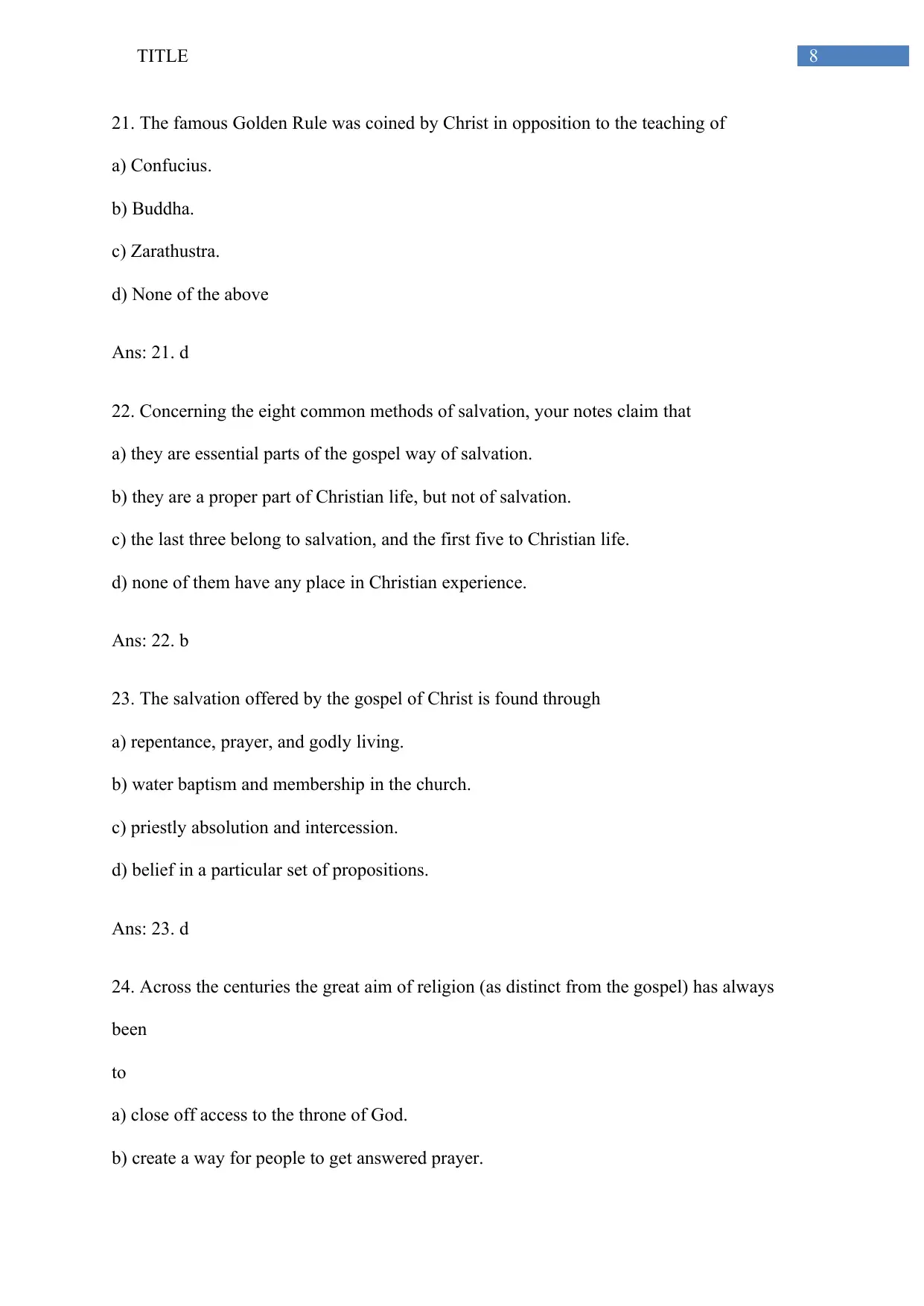
8TITLE
21. The famous Golden Rule was coined by Christ in opposition to the teaching of
a) Confucius.
b) Buddha.
c) Zarathustra.
d) None of the above
Ans: 21. d
22. Concerning the eight common methods of salvation, your notes claim that
a) they are essential parts of the gospel way of salvation.
b) they are a proper part of Christian life, but not of salvation.
c) the last three belong to salvation, and the first five to Christian life.
d) none of them have any place in Christian experience.
Ans: 22. b
23. The salvation offered by the gospel of Christ is found through
a) repentance, prayer, and godly living.
b) water baptism and membership in the church.
c) priestly absolution and intercession.
d) belief in a particular set of propositions.
Ans: 23. d
24. Across the centuries the great aim of religion (as distinct from the gospel) has always
been
to
a) close off access to the throne of God.
b) create a way for people to get answered prayer.
21. The famous Golden Rule was coined by Christ in opposition to the teaching of
a) Confucius.
b) Buddha.
c) Zarathustra.
d) None of the above
Ans: 21. d
22. Concerning the eight common methods of salvation, your notes claim that
a) they are essential parts of the gospel way of salvation.
b) they are a proper part of Christian life, but not of salvation.
c) the last three belong to salvation, and the first five to Christian life.
d) none of them have any place in Christian experience.
Ans: 22. b
23. The salvation offered by the gospel of Christ is found through
a) repentance, prayer, and godly living.
b) water baptism and membership in the church.
c) priestly absolution and intercession.
d) belief in a particular set of propositions.
Ans: 23. d
24. Across the centuries the great aim of religion (as distinct from the gospel) has always
been
to
a) close off access to the throne of God.
b) create a way for people to get answered prayer.
⊘ This is a preview!⊘
Do you want full access?
Subscribe today to unlock all pages.

Trusted by 1+ million students worldwide
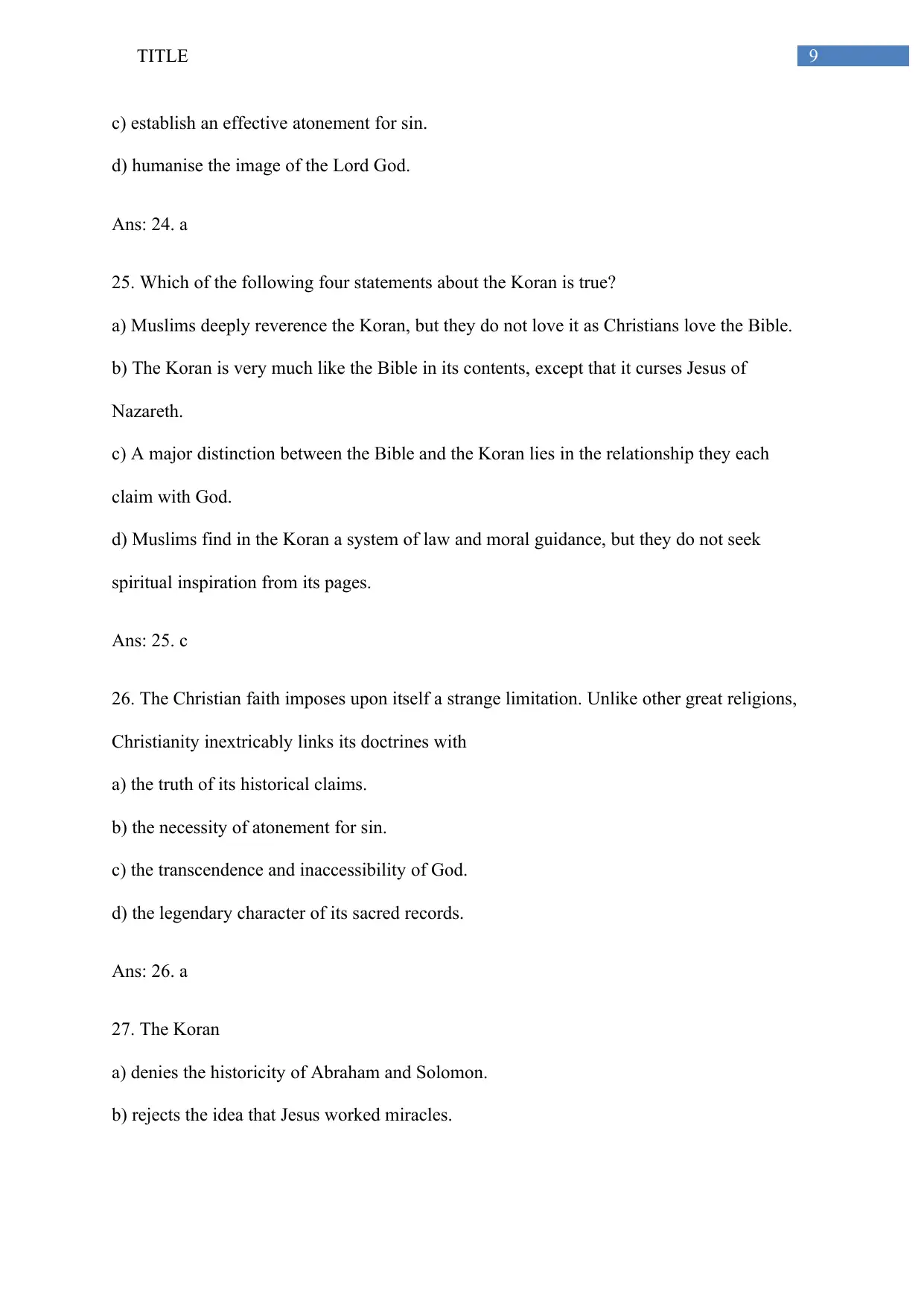
9TITLE
c) establish an effective atonement for sin.
d) humanise the image of the Lord God.
Ans: 24. a
25. Which of the following four statements about the Koran is true?
a) Muslims deeply reverence the Koran, but they do not love it as Christians love the Bible.
b) The Koran is very much like the Bible in its contents, except that it curses Jesus of
Nazareth.
c) A major distinction between the Bible and the Koran lies in the relationship they each
claim with God.
d) Muslims find in the Koran a system of law and moral guidance, but they do not seek
spiritual inspiration from its pages.
Ans: 25. c
26. The Christian faith imposes upon itself a strange limitation. Unlike other great religions,
Christianity inextricably links its doctrines with
a) the truth of its historical claims.
b) the necessity of atonement for sin.
c) the transcendence and inaccessibility of God.
d) the legendary character of its sacred records.
Ans: 26. a
27. The Koran
a) denies the historicity of Abraham and Solomon.
b) rejects the idea that Jesus worked miracles.
c) establish an effective atonement for sin.
d) humanise the image of the Lord God.
Ans: 24. a
25. Which of the following four statements about the Koran is true?
a) Muslims deeply reverence the Koran, but they do not love it as Christians love the Bible.
b) The Koran is very much like the Bible in its contents, except that it curses Jesus of
Nazareth.
c) A major distinction between the Bible and the Koran lies in the relationship they each
claim with God.
d) Muslims find in the Koran a system of law and moral guidance, but they do not seek
spiritual inspiration from its pages.
Ans: 25. c
26. The Christian faith imposes upon itself a strange limitation. Unlike other great religions,
Christianity inextricably links its doctrines with
a) the truth of its historical claims.
b) the necessity of atonement for sin.
c) the transcendence and inaccessibility of God.
d) the legendary character of its sacred records.
Ans: 26. a
27. The Koran
a) denies the historicity of Abraham and Solomon.
b) rejects the idea that Jesus worked miracles.
Paraphrase This Document
Need a fresh take? Get an instant paraphrase of this document with our AI Paraphraser
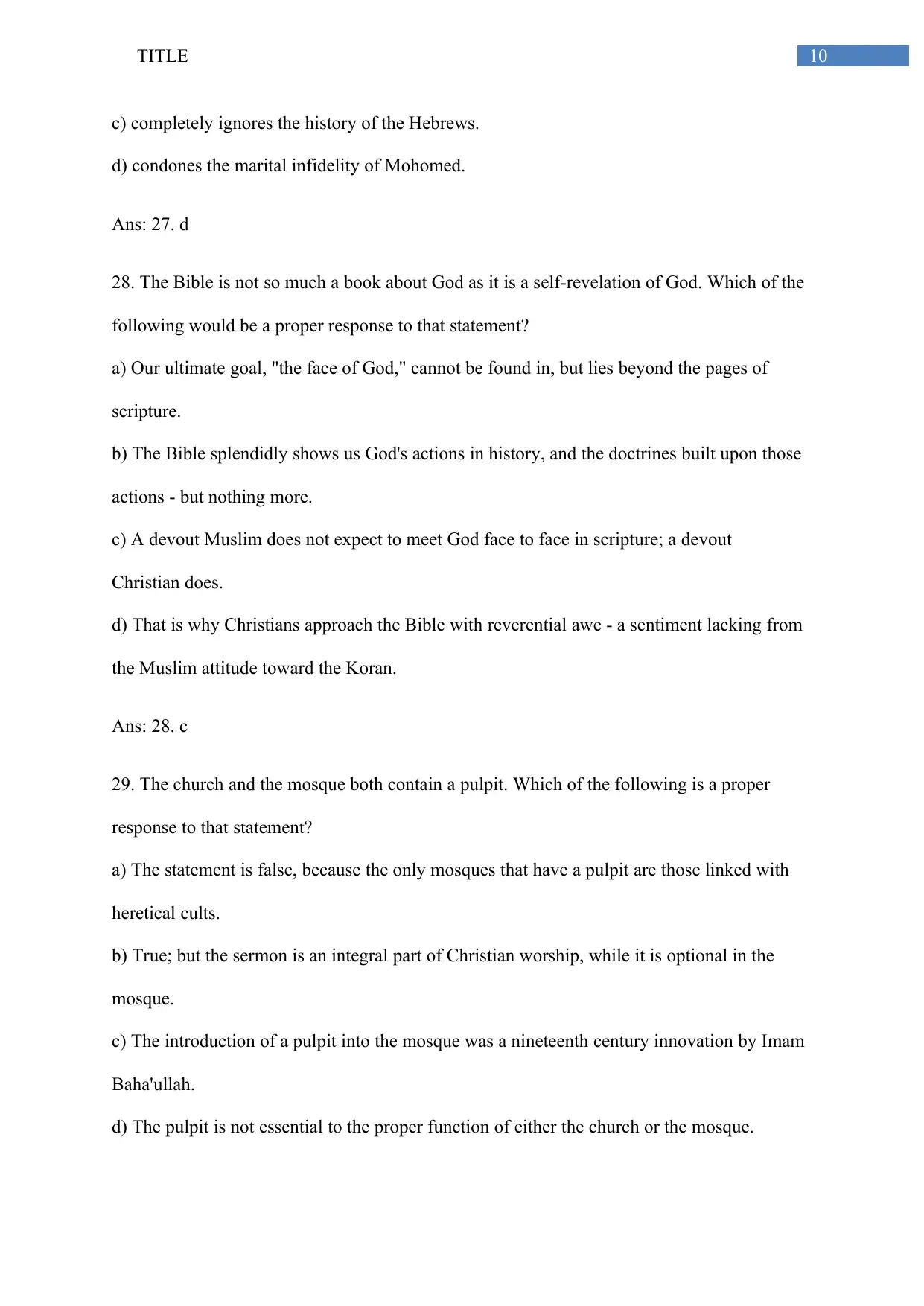
10TITLE
c) completely ignores the history of the Hebrews.
d) condones the marital infidelity of Mohomed.
Ans: 27. d
28. The Bible is not so much a book about God as it is a self-revelation of God. Which of the
following would be a proper response to that statement?
a) Our ultimate goal, "the face of God," cannot be found in, but lies beyond the pages of
scripture.
b) The Bible splendidly shows us God's actions in history, and the doctrines built upon those
actions - but nothing more.
c) A devout Muslim does not expect to meet God face to face in scripture; a devout
Christian does.
d) That is why Christians approach the Bible with reverential awe - a sentiment lacking from
the Muslim attitude toward the Koran.
Ans: 28. c
29. The church and the mosque both contain a pulpit. Which of the following is a proper
response to that statement?
a) The statement is false, because the only mosques that have a pulpit are those linked with
heretical cults.
b) True; but the sermon is an integral part of Christian worship, while it is optional in the
mosque.
c) The introduction of a pulpit into the mosque was a nineteenth century innovation by Imam
Baha'ullah.
d) The pulpit is not essential to the proper function of either the church or the mosque.
c) completely ignores the history of the Hebrews.
d) condones the marital infidelity of Mohomed.
Ans: 27. d
28. The Bible is not so much a book about God as it is a self-revelation of God. Which of the
following would be a proper response to that statement?
a) Our ultimate goal, "the face of God," cannot be found in, but lies beyond the pages of
scripture.
b) The Bible splendidly shows us God's actions in history, and the doctrines built upon those
actions - but nothing more.
c) A devout Muslim does not expect to meet God face to face in scripture; a devout
Christian does.
d) That is why Christians approach the Bible with reverential awe - a sentiment lacking from
the Muslim attitude toward the Koran.
Ans: 28. c
29. The church and the mosque both contain a pulpit. Which of the following is a proper
response to that statement?
a) The statement is false, because the only mosques that have a pulpit are those linked with
heretical cults.
b) True; but the sermon is an integral part of Christian worship, while it is optional in the
mosque.
c) The introduction of a pulpit into the mosque was a nineteenth century innovation by Imam
Baha'ullah.
d) The pulpit is not essential to the proper function of either the church or the mosque.
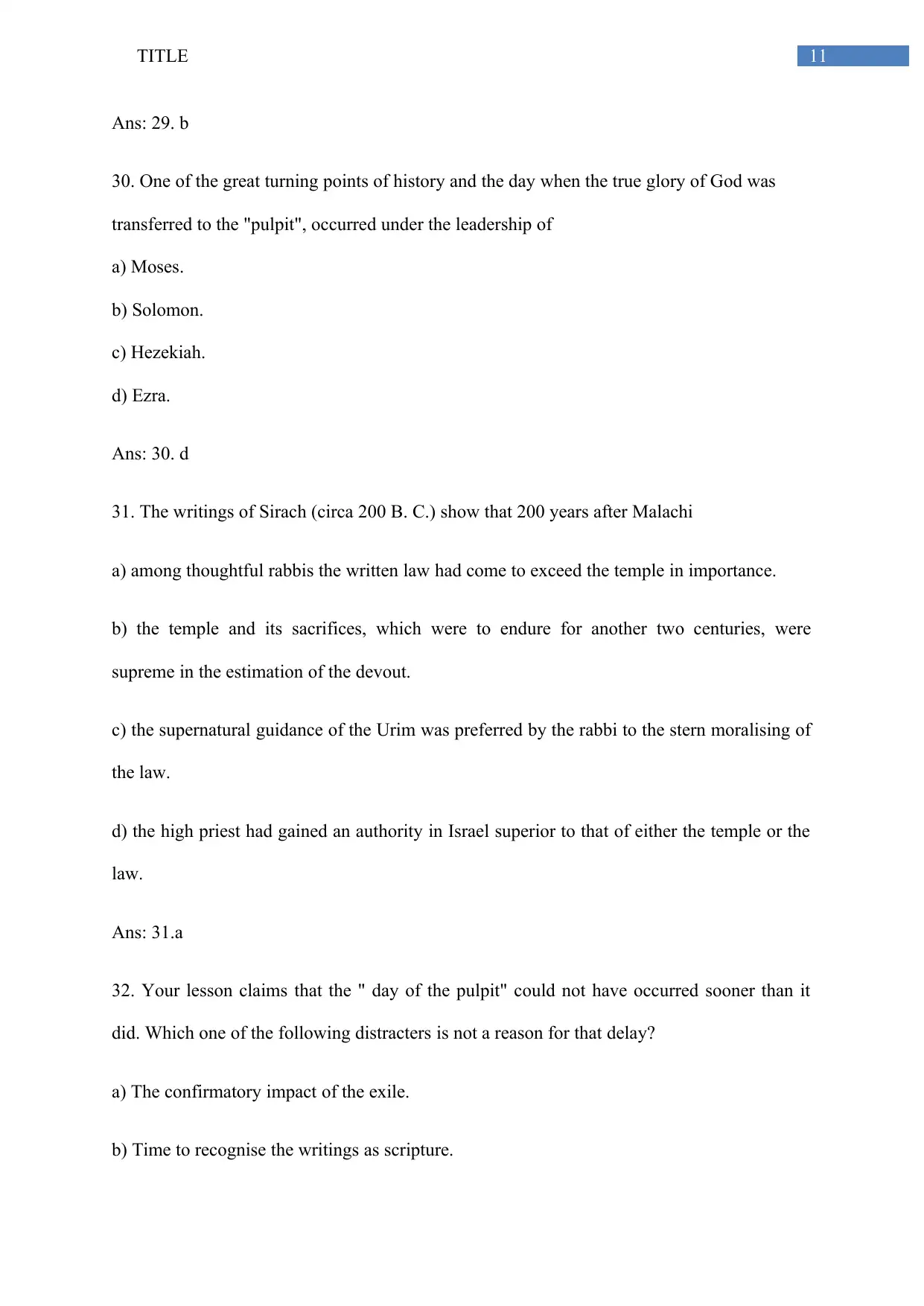
11TITLE
Ans: 29. b
30. One of the great turning points of history and the day when the true glory of God was
transferred to the "pulpit", occurred under the leadership of
a) Moses.
b) Solomon.
c) Hezekiah.
d) Ezra.
Ans: 30. d
31. The writings of Sirach (circa 200 B. C.) show that 200 years after Malachi
a) among thoughtful rabbis the written law had come to exceed the temple in importance.
b) the temple and its sacrifices, which were to endure for another two centuries, were
supreme in the estimation of the devout.
c) the supernatural guidance of the Urim was preferred by the rabbi to the stern moralising of
the law.
d) the high priest had gained an authority in Israel superior to that of either the temple or the
law.
Ans: 31.a
32. Your lesson claims that the " day of the pulpit" could not have occurred sooner than it
did. Which one of the following distracters is not a reason for that delay?
a) The confirmatory impact of the exile.
b) Time to recognise the writings as scripture.
Ans: 29. b
30. One of the great turning points of history and the day when the true glory of God was
transferred to the "pulpit", occurred under the leadership of
a) Moses.
b) Solomon.
c) Hezekiah.
d) Ezra.
Ans: 30. d
31. The writings of Sirach (circa 200 B. C.) show that 200 years after Malachi
a) among thoughtful rabbis the written law had come to exceed the temple in importance.
b) the temple and its sacrifices, which were to endure for another two centuries, were
supreme in the estimation of the devout.
c) the supernatural guidance of the Urim was preferred by the rabbi to the stern moralising of
the law.
d) the high priest had gained an authority in Israel superior to that of either the temple or the
law.
Ans: 31.a
32. Your lesson claims that the " day of the pulpit" could not have occurred sooner than it
did. Which one of the following distracters is not a reason for that delay?
a) The confirmatory impact of the exile.
b) Time to recognise the writings as scripture.
⊘ This is a preview!⊘
Do you want full access?
Subscribe today to unlock all pages.

Trusted by 1+ million students worldwide
1 out of 39
Your All-in-One AI-Powered Toolkit for Academic Success.
+13062052269
info@desklib.com
Available 24*7 on WhatsApp / Email
![[object Object]](/_next/static/media/star-bottom.7253800d.svg)
Unlock your academic potential
Copyright © 2020–2025 A2Z Services. All Rights Reserved. Developed and managed by ZUCOL.
